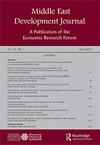Institutional quality and inward FDI: empirical evidence from GCC economies
IF 0.9
Q4 DEVELOPMENT STUDIES
引用次数: 0
Abstract
ABSTRACTThis paper studies the determinants of inward foreign direct investment (FDI) across the Gulf Corporation Council (GCC) countries between 2009 and 2017 using a modified knowledge-capital model of the multinational firm. In particular, we investigate the importance of institutional quality factors. We document the significant effects of institutional characteristics such as government effectiveness, control of corruption, political stability and rule of law, while regulatory quality was found to be less important. Moreover, our study finds that the GCC countries’ FDI can be explained by horizontal market seeking rather than efficiency-seeking vertical motives. Finally, the extended specification results highlight the significant effects of colonial relationships, common language and contiguity.KEYWORDS: Foreign direct investmentGCC regioninstitutional qualitypseudo-poisson maximum likelihoodknowledge capital modelJEL CLASSIFICATION: F23 AcknowledgmentThe authors would like to thank two anonymous reviewers for their constructive comments and suggestions. We are also gratefully acknowledging Oleg Gurshev in the Department of Economic Sciences at the University of Warsaw for reading and commenting on the previous drafts of the paper.Disclosure statementNo potential conflict of interest was reported by the author(s).Notes1 They argue that the GCC region features a lower institutional quality relative to the other regions around the world and suffers from flawed institutions at numerous levels, including the malfunctioning of public administration, shortages in political rights, and ineffective laws and regulations.2 These reforms incorporated incentives such as tax waivers, relaxed restrictions on foreign ownership, and removal of trade barriers.3 The GCC countries have signed over 200 BITs, where Kuwait is the leader followed by the UAE and Qatar.4 The examples include Méon and Sekkat (Citation2004), Mina (Citation2007), Aziz and Mishra (Citation2016), and Aziz (Citation2018).5 Their seminal models have been extended by, inter alia, Horstmann and Markusen (Citation1987), Markusen & Venables (Citation1998; Citation2000), Helpman et al. (Citation2004), Cieślik and Ryan (Citation2012).6 In the horizontal type of FDI, firms face the trade-off between maximizing proximity to households and concentrating production to achieve economies of scale. In contrast, the vertical type of FDI is related to countries’ differences in relative factor endowments. Thus, the decision of firms to engage in horizontal FDI would be driven by the size and growth of the host country, whereas vertical FDI seeks cost competitiveness and other factors such as quality of domestic institutions, political risk, and physical infrastructure.7 The GCC countries include Bahrain, Kuwait, Oman, Qatar, Saudi Arabia, and the United Arab Emirates (UAE).8 Our bilateral data covers Saudi Arabia and the United Arab Emirates due to nearly all of the GCC countries do not report outward FDI statistics (e.g. Bahrain, Oman, Qatar and Kuwait). Our final bilateral dataset has 5037 observations, 3031 (65%) of which constitute ‘zero’ FDI.9 The complete list of investment partners is shown in Table A2 in the Appendix.10 The following facts dictate the use of FDI stock data. First, FDI stock is significantly more across-the-board and readily available for a large economy group than affiliate sales. Second, unlike flow data (net FDI), which is essentially a sum of equity and debt instruments, stock data holds only the reported accurate capital equity owned by foreign affiliates in a given host economy. Besides, FDI stock data represent ‘the long-run factors that explain the distribution of FDI’ (Blonigen & Piger, Citation2014, p. 782). Finally, the extant empirical literature has taken advantage of the use of stock data, (e.g. Awokuse et al., Citation2012; Blonigen & Piger, Citation2014; Camarero et al., Citation2019; Cieślik et al., Citation2021).11 These observations are omitted from the estimation as we rely on the logarithmic transformation.12 The detailed definitions of our explanatory variables are provided in Table A3 while pairwise correlations are reported in Table A4 reports in the Appendix.13 In Table A5 in the Appendix, we use the average years of schooling as an alternative measure of human capital. The average number of years spent in school is a commonly used measure of a population’s education level. It allows aggregation of attainment across education levels and allows an analysis of the ‘stock of human capital’ that a population has at any given point in time. The data refer to Our World in Data based on Lee and Lee (Citation2016).14 The six governance indicators are based on 31 underlying data sources reporting the governance perceptions of a large number of survey respondents worldwide. Details on the underlying data sources, the aggregation method, and the interpretation of the indicators can be found in Kaufmann et al. (Citation2009; Citation2010).15 These include bilateral investment treaties (BIT), contiguity (Contig), common spoken language (ComLang), and common colonizer post-1945 (ComCol). These variables are widely used in the FDI literature (e.g. Bergstrand & Egger, Citation2013; Blonigen & Piger, Citation2014; Nguyen et al., Citation2020).16 The PPML has several desirable properties. First, it assists in mitigating Jensen’s inequality, which is the following: E[g(X)]≠ln[E(y)]. One of the implications of Jensen’s inequality is that when we take the logarithm of the explanatory variables, lower values and disinvestment values in the data values automatically become zero. In the empirical analysis, the OLS estimators cannot read zero values that may generate inconsistent and biased estimation results. It also increases the heteroscedasticity in the empirical analysis that E[yi|x]=exp(xiβ)∝V[yi|x], where βs can be estimated by solving the following set of first-order conditions: ∑i=1n[yi−exp(xiβ~)]xi=0.17 This result differs from existing studies, which typically find a negative relationship between FDI and the interaction between BIT and colonial past such as Gurshev and Hamza (Citation2021).18 The RESET test in our estimations is higher than in previous studies such as Nguyen et al. (Citation2020).体制质量与外国直接投资:来自海湾合作委员会经济体的经验证据
摘要本文利用修正的跨国公司知识资本模型,研究了2009 - 2017年海湾合作委员会(GCC)成员国外国直接投资(FDI)的决定因素。我们特别研究了制度质量因素的重要性。我们记录了制度特征的显著影响,如政府效率、腐败控制、政治稳定和法治,而监管质量则不太重要。此外,我们的研究发现,海湾合作委员会国家的FDI可以用横向的市场追求动机来解释,而不是用纵向的效率追求动机来解释。最后,扩展的规范结果强调了殖民地关系、共同语言和邻近性的显著影响。关键词:外国直接投资;海湾合作委员会区域制度质量;拟泊松最大似然;知识资本模型;分类:F23感谢两位匿名审稿人提出的建设性意见和建议。我们还要感谢华沙大学经济科学系的Oleg Gurshev阅读并评论了本文的前几份草稿。披露声明作者未报告潜在的利益冲突。注1他们认为,与世界上其他地区相比,海湾合作委员会地区的制度质量较低,并且在许多层面上都存在缺陷,包括公共行政失灵、政治权利短缺和法律法规无效这些改革包括减免税收、放宽对外资所有权的限制和消除贸易壁垒等激励措施海湾合作委员会国家已经签署了200多个双边投资协定,其中科威特是领导者,其次是阿联酋和卡塔尔。4例子包括m<s:1>和塞卡特(Citation2004),米娜(Citation2007),阿齐兹和米什拉(Citation2016),阿齐兹(Citation2018)他们的开创性模型被Horstmann和Markusen (Citation1987), Markusen和Venables (Citation1998;5 . Citation2000), Helpman et al. (Citation2004), Cieślik and Ryan (Citation2012)在横向类型的外国直接投资中,公司面临着最大限度地接近家庭和集中生产以实现规模经济之间的权衡。而FDI的纵向类型则与各国相对要素禀赋的差异有关。因此,公司从事横向外国直接投资的决定将受到东道国的规模和增长的推动,而纵向外国直接投资则寻求成本竞争力和其他因素,如国内机构的质量、政治风险和有形基础设施海湾合作委员会成员国包括巴林、科威特、阿曼、卡塔尔、沙特阿拉伯和阿拉伯联合酋长国我们的双边数据涵盖了沙特阿拉伯和阿拉伯联合酋长国,因为几乎所有海湾合作委员会国家都没有报告对外直接投资统计数据(如巴林、阿曼、卡塔尔和科威特)。我们最终的双边数据集有5037个观察值,其中3031个(65%)构成“零”外国直接投资。9投资伙伴的完整列表见附录中的表A2。首先,对于一个大型经济集团来说,外国直接投资的股票比联营销售更全面、更容易获得。其次,与流动数据(外国直接投资净额)不同,流动数据(外国直接投资净额)本质上是股票和债务工具的总和,而股票数据只包含特定东道国经济中外国附属公司所报告的准确资本权益。此外,FDI存量数据代表了“解释FDI分布的长期因素”(Blonigen & Piger, Citation2014, p. 782)。最后,现有的实证文献利用了股票数据的优势(如Awokuse et al., Citation2012;Blonigen & Piger, Citation2014;Camarero et al., Citation2019;11 . Cieślik等人,Citation2021)由于我们依靠对数变换,这些观测值从估计中省略了我们的解释变量的详细定义在表A3中提供,而两两相关性在附录的表A4报告中报告。13在附录的表A5中,我们使用平均受教育年限作为人力资本的另一种衡量标准。平均受教育年数是衡量人口教育水平的常用指标。它可以汇总不同教育水平的成就,并可以分析人口在任何给定时间点所拥有的“人力资本存量”。数据参考基于Lee and Lee (Citation2016)的Our World in data六个治理指标基于31个基础数据源,这些数据源报告了全球大量调查受访者的治理看法。有关基础数据源、汇总方法和指标解释的详细信息可在Kaufmann等人的文章中找到。
本文章由计算机程序翻译,如有差异,请以英文原文为准。
求助全文
约1分钟内获得全文
求助全文

 求助内容:
求助内容: 应助结果提醒方式:
应助结果提醒方式:


